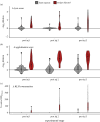No evidence of metabolic costs following adaptive immune activation or reactivation in house sparrows
- PMID: 35702980
- PMCID: PMC9198745
- DOI: 10.1098/rsbl.2022.0036
No evidence of metabolic costs following adaptive immune activation or reactivation in house sparrows
Abstract
The energy cost of adaptive immune activation in endotherms is typically quantified from changes in resting metabolic rate following exposure to a novel antigen. An implicit assumption of this technique is that all variation in energy costs following antigenic challenge is due solely to adaptive immunity, while ignoring potential changes in the energy demands of ongoing bodily functions. We critically assess this assumption by measuring both basal metabolic rate (BMR) and exercise-induced maximal metabolic rate (MMR) in house sparrows before and after the primary and two subsequent vaccinations with either saline (sham) or two novel antigens (keyhole limpet haemocyanin and sheep red blood cells; KLH and SRBC, respectively). We also examined the effect of inducing male breeding levels of testosterone (T) on immune responses and their metabolic costs in both males and females. Although there was a moderate decrease in KLH antibody formation in T-treated birds, there was no effect of T on BMR, MMR or immunity to SRBC. There was no effect of vaccination on BMR but, surprisingly, all vaccinated birds maintained MMR better than sham-treated birds as the experiment progressed. Our findings caution against emphasizing energy costs or nutrient diversion as being responsible for reported fitness reductions following activation of adaptive immunity.
Keywords: adaptive immune costs; basal metabolic rate; hypervaccination; immunocompetence handicap hypothesis; maximum metabolic rate; testosterone.
Figures


Similar articles
-
Among- and within-individual correlations between basal and maximal metabolic rates in birds.J Exp Biol. 2014 Oct 15;217(Pt 20):3593-6. doi: 10.1242/jeb.108704. Epub 2014 Sep 4. J Exp Biol. 2014. PMID: 25189368
-
Intraspecific correlations of basal and maximal metabolic rates in birds and the aerobic capacity model for the evolution of endothermy.PLoS One. 2012;7(3):e34271. doi: 10.1371/journal.pone.0034271. Epub 2012 Mar 27. PLoS One. 2012. PMID: 22479584 Free PMC article.
-
Cross-training in birds: cold and exercise training produce similar changes in maximal metabolic output, muscle masses and myostatin expression in house sparrows (Passer domesticus).J Exp Biol. 2015 Jul;218(Pt 14):2190-200. doi: 10.1242/jeb.121822. Epub 2015 May 18. J Exp Biol. 2015. PMID: 25987736 Free PMC article.
-
How low can you go? An adaptive energetic framework for interpreting basal metabolic rate variation in endotherms.J Comp Physiol B. 2017 Dec;187(8):1039-1056. doi: 10.1007/s00360-017-1096-3. Epub 2017 Apr 11. J Comp Physiol B. 2017. PMID: 28401293 Review.
-
Phenotypic flexibility in basal metabolic rate and the changing view of avian physiological diversity: a review.J Comp Physiol B. 2008 Mar;178(3):235-47. doi: 10.1007/s00360-007-0218-8. Epub 2007 Oct 24. J Comp Physiol B. 2008. PMID: 17957373 Review.
References
-
- Graham JL, Mady RP, Greives TJ. 2017. Experimental immune activation using a mild antigen decreases reproductive success in free-living female dark-eyed juncos (Junco hyemalis). Can. J. Zool. 95, 263-269. (10.1139/cjz-2016-0131) - DOI
Publication types
MeSH terms
Associated data
LinkOut - more resources
Full Text Sources

